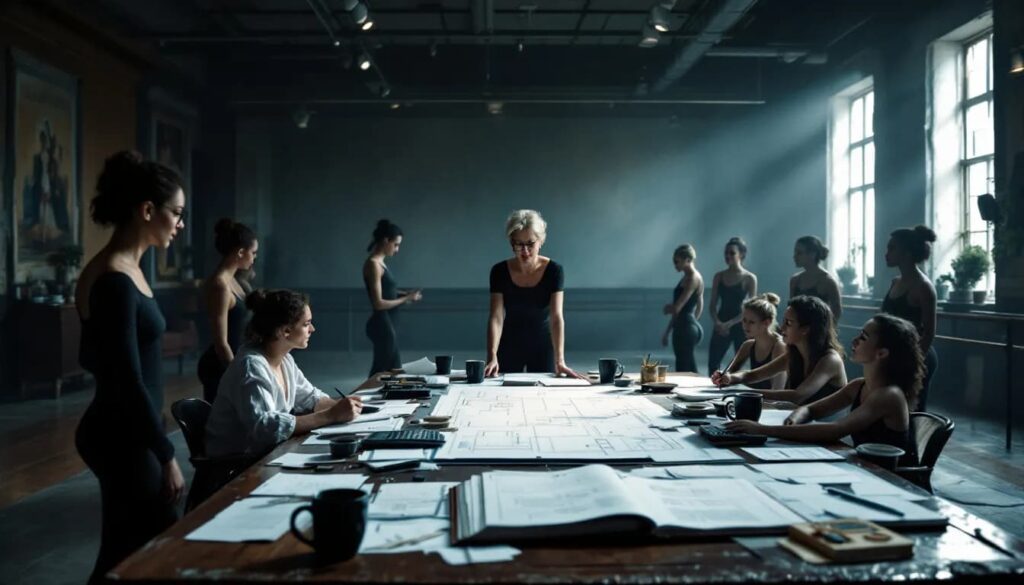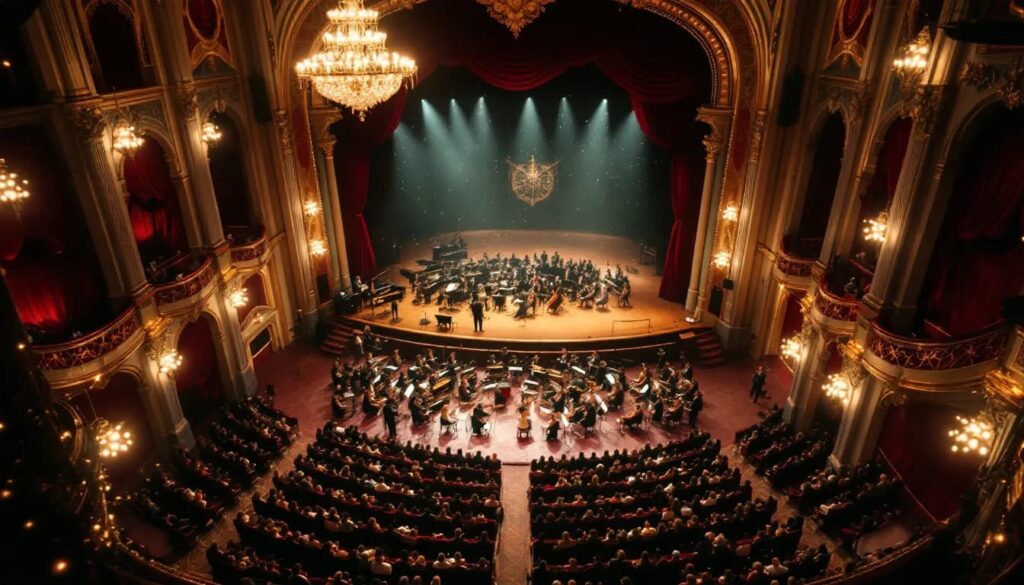Wondering how much it costs to produce a ballet? This article breaks down ballet production costs, covering everything from venue rental to costumes and staffing.
At the outset, we want to extend our warmest thanks to artdeballet.com for providing the outstanding material and insights that form the backbone of this article. Their innovative approach and dedication to excellence have enriched our content, and we are excited to share their work with you.
Key Takeaways
- Effective initial planning and budgeting are crucial for managing production costs and setting realistic ticket prices.
- Venue rental costs significantly impact production expenses; flexible rental options can lead to substantial savings.
- Understanding and planning for miscellaneous expenses, such as travel and accommodation, is essential to avoid budget overruns in ballet productions.
Understanding Ballet Production Costs
Ballet production costs can be broken down into several key categories, each contributing to the overall financial demands of staging a performance. These include dancer salaries, costume costs, theater rental fees, and marketing expenses. The production scale significantly influences these costs, with larger productions requiring more dancers, elaborate costumes, and advanced technical equipment.
For instance, the cost of producing a ballet can vary widely. A small, local production might have modest expenses, while a grand, professional performance could incur substantial costs. Diablo Ballet says ticket sales only cover about 20% of their expenses, underscoring the need for additional revenue streams to support the production. This gap highlights the importance of strategic financial planning and the pursuit of supplementary funding sources to ensure the viability of the production.
Initial Planning and Budgeting

Effective initial planning is the cornerstone of any successful ballet production, where you assess your project’s viability and financial health. Managing the myriad costs involved can quickly become overwhelming without a well-structured budget. A comprehensive budget helps identify potential expenses, enabling better financial management throughout production.
A financial forecast anticipates cash flows, ensuring funds are available for all production phases. It helps set realistic ticket prices and manage resources effectively. Reducing production costs allows for more competitive ticket prices, which is crucial for attracting audiences. Additionally, having a clear policy on missed classes and allowing students to make up these sessions can help maintain engagement and continuity in learning, ultimately contributing to a more efficient use of resources.
Knowing your audience demographics and local competition is vital. Larger studios may opt for lower ticket prices to encourage attendance, while many studios might need to raise ticket prices to cover costs. Considering these factors early helps you set a budget that covers expenses and appeals to your target audience.
Venue and Theater Rental Costs

The venue rental is one of dance production’s most significant cost factors. The choice of venue can profoundly impact your overall production costs. For instance, renting the Palladium Concert Hall can range from $6,000 on weekdays to $7,000 on weekends, while the Studio Theater offers a more affordable option at $1,500 with a flexible seating arrangement. The Tarkington Theater, with a rental rate of $2,500, can seat up to 500 guests, providing a middle-ground option.
A venue with sliding-scale rental options can yield significant savings. For example, a weekly theater rental cost under a subsidized option can be as low as $1,600. These savings can be allocated to other essential production areas, such as costumes or marketing.
Also, consider any additional services or charges during a venue rental. These could include costs for technical equipment, staffing, and other specific event requirements. Understanding these costs upfront helps avoid unexpected expenses and stay within budget.
Rehearsal Space Expenses
Rehearsal space is another critical component requiring careful budgeting. Over four years, the total estimated cost of studio space rental can amount to $15,600. This significant expense underscores the need to secure a suitable rehearsal venue early, ensuring dancers have ample space to perfect their performances. Scheduling a dress rehearsal is crucial, as it ensures that all performance elements come together seamlessly, highlighting the importance of preparation and practice for the event.
For those without a fiscal sponsor or non-profit connection, one rehearsal can cost $75. These costs add up quickly, making planning and allocating funds for rehearsal spaces crucial. This ensures your production fees stay on track without compromising rehearsal quality.
Rehearsal and Performance Logistics
Rehearsal and performance logistics are critical to the success of any ballet production. Securing rehearsal space is a significant expense, often reaching $25 per hour. These costs can accumulate quickly for a typical rehearsal schedule of three hours per week. Paying dancers a minimum of $5 per rehearsal adds to the financial burden.
Beyond rehearsal space, choreographers must also consider the cost of costumes, ranging from $60 to $100 per dancer. These expenses are necessary to ensure that dancers are adequately prepared and the production maintains a high performance standard. Effective planning and budgeting for these logistics are essential to keep the production on track and within budget.
Costumes and Costume Fees

Costumes are vital for bringing a ballet production to life but represent a significant portion of the budget. The costs associated with costumes are influenced by factors such as design complexity, creation, and rental options. High-quality costumes enhance the performance but require careful financial planning.
Utilizing volunteers for set design and costume creation can help manage costume expenses. A costume designer might contribute by dyeing costumes and making masks for free, significantly reducing costs. A vision board helps visualize how costumes will look together, aiding cohesive design choices and minimizing expenses.
Considering costume rental options can be a cost-effective alternative to creating new costumes. Balancing rented and custom-made costumes achieves the desired aesthetic without exceeding the budget.
Hiring and Compensation
Hiring the right personnel is crucial but comes with financial challenges. When hiring staff, it is important to consider minimum wage laws and budget constraints. Ensuring fair compensation while managing costs requires a delicate balance, especially when paying employees.
Utilize unpaid apprentices to manage costs, allowing them to take on smaller roles while understudying larger ones. This approach provides valuable experience for apprentices and helps keep the budget in check. Be prepared for necessary reimbursements as well. A self-paid reimbursement of $1,000 can show how personal funds might assist in managing production costs.
New choreographers should know that producing a ballet is a full-time job for a dancer. This reality influences hiring decisions, underscoring the need for dedicated personnel fully committed to the production.
Music Licensing and Insurance
Music is a fundamental element of ballet, and securing the right to use copyrighted music involves paying fees. These fees ensure that proper royalties are paid to artists and copyright holders. ReduceYou can reduce costs by using royalty-free music, negotiating with copyright holders, or creating original compositions. Each option helps manage expenses while providing the musical backdrop for your performance.
Liability insurance is another essential component of ballet production. It protects against claims related to injuries or damages that occur during performances or rehearsals. To minimize liability insurance costs, compare quotes from different providers, consider higher deductibles, and ensure the coverage aligns with your production’s needs. Proper insurance coverage is essential, providing peace of mind and financial protection against unforeseen incidents.
Production and Technical Costs

Technical production costs are crucial to a ballet performance’s success. These include lighting, sound, and set design, contributing to the overall aesthetic and functionality of the production. Knowing these expenses is critical for effective budget management.
Anticipating technical production costs means budgeting for equipment rentals and crew salaries, including the stage manager. Effectively managing these costs ensures the necessary resources for a high-quality performance. Planning these expenses from the outset allows for better financial control and avoids last-minute surprises.
Budgeting for technical production requires careful planning to account for design, implementation, and labor. This ensures every technical element is executed flawlessly, enhancing the overall impact of your ballet production.
Marketing and Promotion
Marketing and promotion are crucial to the success of any ballet production. A significant advertising and public relations budget is necessary, especially for nonprofit companies. Knowing your audience demographics and preferences is crucial for tailoring marketing campaigns that resonate and attract more patrons.
Consistent branding across all marketing materials creates familiarity, making it easier for potential attendees to recognize and engage with the performance. Social media platforms can promote content, including behind-the-scenes looks and interviews, to engage potential audiences and stimulate ticket sales.
An online ticketing system streamlines sales and reduces the costs of traditional box office operations. This simplifies customer ticket purchasing and helps manage sales more efficiently.
Revenue Streams
Ballet productions have diverse revenue streams, including ticket sales, fees, and grants. While ticket sales can generate significant revenue, they often do not cover the full cost of production. Many studios find that ticket sales only account for a fraction of their overall expenses, necessitating exploring additional income sources.
Production fees, such as those charged by dance festivals, can provide a valuable source of income. These fees help offset some of the production costs and can be a crucial component of the overall budget. Additionally, grants from organizations that support the arts can offer substantial financial support. These grants are often competitive but can provide the necessary funds to bridge the gap between ticket sales and total production costs.
Ticket Sales and Revenue

Understanding the market and competition is crucial for determining effective ticket pricing strategies and overall budget considerations. A common misconception is that ticket sales cover the production cost, leading to unrealistic budget expectations. In reality, only 20% of Diablo Ballet’s expenses are covered by ticket sales, showing the need for alternative revenue sources.
Projected sales forecasts and cost analysis are essential for setting realistic ticket prices. For example, the total ticket sales total from a recent performance was $5,131.65, but the venue fee deducted from ticket sales was $8. These figures underscore the importance of effective pricing and promotional tactics, such as offering promotional codes and bundle deals, to incentivize ticket purchases.
An effective website for a ballet performance should feature seamless ticket purchasing options and be mobile-friendly to enhance the user experience. Automated email marketing effectively communicates with subscribers, keeping them informed before, during, and after ticket sales.
Managing Financial Risks
Managing financial risks is a crucial aspect of ballet production. Choreographers must carefully budget for various expenses, including dancer salaries, costume costs, and theater rental fees. They must also account for potential disruptions, such as missed performances or rehearsals due to unforeseen circumstances like inclement weather or dancer injuries.
Liability insurance plays a vital role in mitigating these risks, providing financial protection against claims related to injuries or damages during performances or rehearsals. However, choreographers must also have a contingency plan to manage unexpected expenses. By anticipating potential financial challenges and planning accordingly, choreographers can help ensure the success and sustainability of their production.
Miscellaneous Expenses
Miscellaneous expenses can significantly impact a ballet production’s overall budget. Travel costs for performers, especially those who travel from out of town, can add up quickly, and accommodation expenses for these performers can also add considerably to production costs.
Unexpected costs may arise during a performance, necessitating a contingency fund. Planning for these miscellaneous expenses ensures preparedness for unforeseen financial challenges during production.
Summary
Producing a ballet involves navigating a complex web of costs, from venue rentals and rehearsal space to costumes and technical expenses. You can create a successful and financially viable production by understanding and managing these costs effectively.
Meticulous planning, realistic budgeting, and strategic financial management are the keys to a successful ballet production. Armed with the insights provided in this guide, you will be well-equipped to bring your ballet vision to life, captivating audiences and creating unforgettable performances.
In closing, we sincerely thank Art de Ballet for their significant contribution to this piece. Their continued commitment to quality and creativity has inspired this article and deepened our understanding of the subject. We are grateful for their support and invite you to explore more of their brilliant work.
Frequently Asked Questions
How much do ballet company members make?
Ballet company members typically earn between $25,000 and $105,000 annually, with an average salary of around $51,557. Major companies often pay dancers about $1,000 weekly over a season, leading to potential six-figure incomes for principal dancers.
How can I reduce music licensing fees for my ballet production?
To reduce music licensing fees for your ballet production, consider using royalty-free music, negotiating directly with copyright holders, or creating original compositions. These strategies can help you manage costs while ensuring the right musical environment for your performance.
What are some cost-saving measures for hiring personnel in a ballet production?
One effective cost-saving measure for hiring personnel in a ballet production is to utilize unpaid apprentices for smaller roles and understudies for larger ones. This approach allows for managing costs while still maintaining a strong cast.
How important is liability insurance for a ballet production?
Liability insurance is essential for a ballet production. It safeguards against claims for injuries or damages during performances or rehearsals, ensuring peace of mind and financial protection.
What role do costumes play in the overall budget of a ballet production?
Costumes significantly impact the overall budget of a ballet production due to factors like design complexity and creation costs. Effective cost management strategies, such as utilizing volunteers and vision boards, can help minimize expenses while maintaining aesthetic quality.
